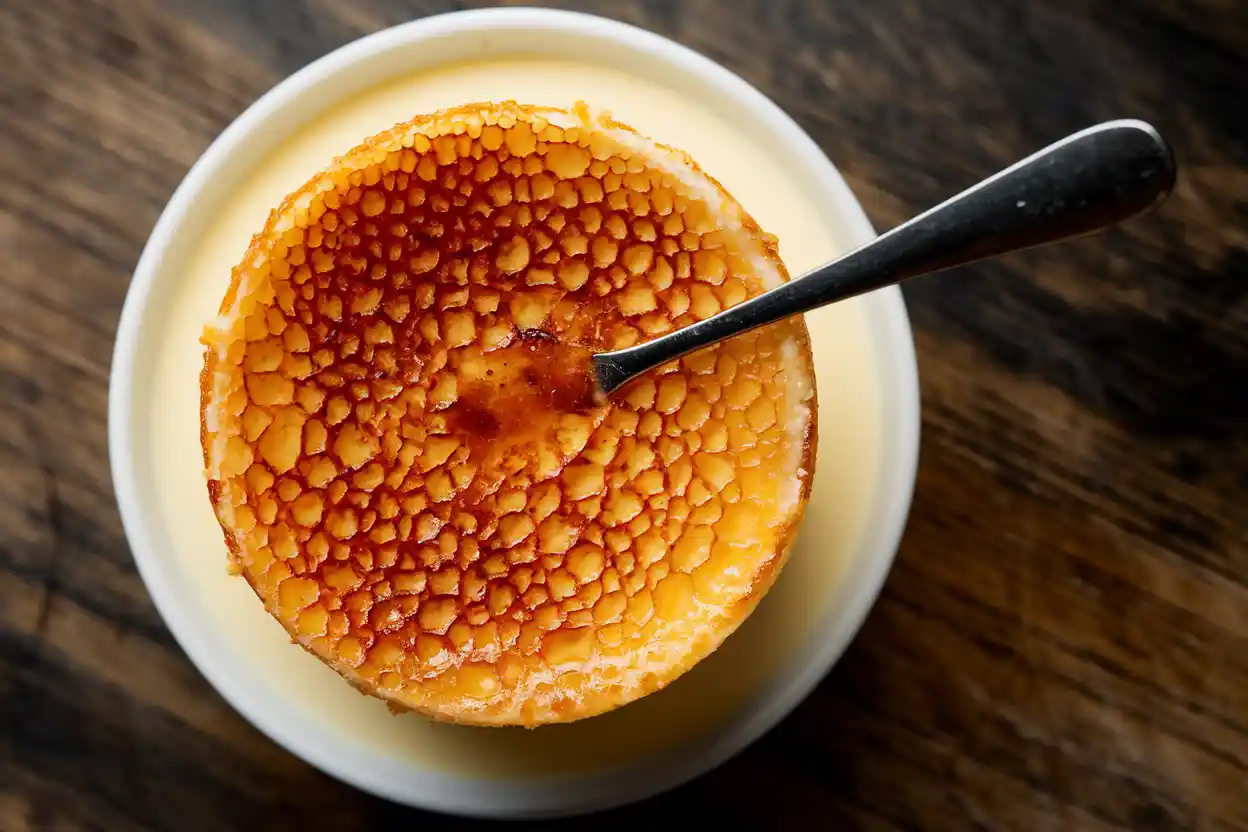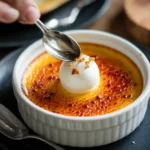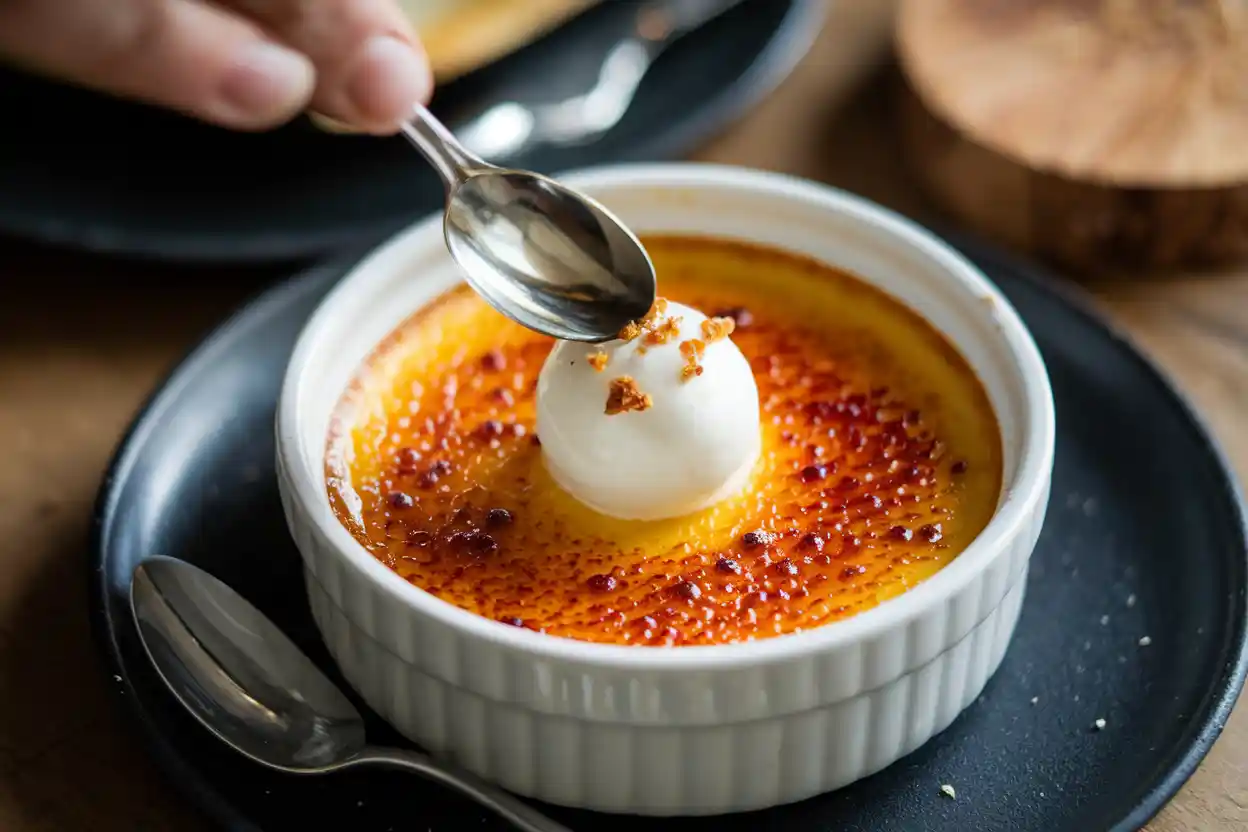Crème brûlée is a classic French dessert that never fails to impress. With its silky-smooth custard base and crisp caramelized sugar topping, this treat is both luxurious and satisfying. But what exactly does crème brûlée taste like? If you’ve never tried it before, imagine a velvety vanilla custard with a hint of caramelized richness—the perfect balance of creamy and crunchy in every bite.
The moment you tap your spoon against the glassy sugar top, you’ll hear a satisfying crack. This thin, caramelized layer provides a deep, slightly bitter contrast to the sweet and creamy custard beneath. The combination of these two textures creates an unforgettable eating experience that keeps dessert lovers coming back for more.
Why It Works
One of the reasons crème brûlée remains a timeless dessert is its flawless balance of simplicity and sophistication. The recipe is based on a foolproof custard technique that ensures a smooth, creamy texture every time. The contrast between the cool, rich custard and the warm, caramelized sugar creates a delightful sensory experience. Additionally, crème brûlée is incredibly versatile—you can easily adjust the sweetness, add different flavor infusions, or even make it dairy-free while maintaining its signature taste and texture.
History & Popularity
Crème brûlée, which translates to “burnt cream” in French, has a history as rich as its flavor. Some records trace its origins back to 17th-century France, while others suggest that similar custard-based desserts appeared in England and Spain around the same time. In fact, the Spanish version, known as crema catalana, shares many similarities but is often flavored with citrus and cinnamon instead of vanilla.
By the 1980s, crème brûlée had cemented its place as a fine dining staple. Renowned chefs across the globe embraced its simple yet sophisticated nature, and soon, home cooks followed suit. The magic of crème brûlée lies in its ability to elevate basic ingredients—eggs, cream, sugar, and vanilla—into something extraordinary. See more about the history and techniques of French cuisine to learn how this dessert evolved over the centuries.

Why You’ll Love It
If you’re a fan of creamy desserts like custard, flan, or pudding, crème brûlée is sure to delight your taste buds. Here are a few reasons why you’ll fall in love with this dessert:
- Perfect Texture Combination: The contrast between the smooth, rich custard and the crunchy caramelized topping is simply irresistible.
- Aromatic & Flavorful: The base is infused with real vanilla, offering a deep and natural sweetness, while the caramelized top adds a smoky depth.
- Simple Yet Elegant: With just a few basic ingredients, you can create a dessert that looks and tastes like it came from a high-end bakery.
- Customizable Flavors: While vanilla is the classic choice, you can infuse crème brûlée with flavors like chocolate, citrus, coffee, or even floral notes like lavender.
- Fun to Make: There’s something incredibly satisfying about using a kitchen torch to caramelize the sugar on top, creating that signature crackly layer. Discover how to make a perfectly caramelized crème brûlée with this unique recipe to get started.
- Pairs Beautifully with Other Desserts: Serve crème brûlée with fresh berries, shortbread cookies, or a drizzle of fruit coulis for an added touch of indulgence.
- A Crowd-Pleaser: Whether you’re entertaining guests or treating yourself, crème brûlée is a universally adored dessert that suits any occasion.
Now that you know why crème brûlée is such a beloved dessert, let’s dive into the ingredients and prep work to get started on your very own homemade version!
What You’ll Need to Make Crème Brûlée
Ingredient List with Measurements
To make the perfect crème brûlée, you’ll need just a handful of basic ingredients:
- 2 cups (480ml) heavy cream – The key to a rich, velvety texture.
- 5 large egg yolks – Provides structure and creaminess.
- ½ cup (100g) granulated sugar – Sweetens the custard and caramelizes for the topping.
- 1 teaspoon pure vanilla extract – Adds classic, aromatic flavor.
- ¼ teaspoon salt – Enhances all the flavors.
- 2 tablespoons (25g) superfine sugar – For the signature caramelized topping.
Ingredient Deep Dive
Each ingredient plays an essential role in achieving the perfect crème brûlée. Here’s why:
- Heavy Cream: Creates a silky, rich custard. Using full-fat cream ensures the best consistency.
- Egg Yolks: They thicken the custard, giving it a smooth, luscious texture.
- Granulated Sugar: Used in both the custard and caramel topping, providing sweetness and that satisfying crunch.
- Vanilla Extract: The traditional flavoring, but you can substitute vanilla bean paste for an even deeper taste.
- Salt: A small but mighty ingredient that balances sweetness and enhances the other flavors.
Substitutions Table
| Ingredient | Substitute |
|---|---|
| Heavy Cream | Half-and-half or coconut cream (for a dairy-free version) |
| Granulated Sugar | Coconut sugar or light brown sugar (for a deeper caramel flavor) |
| Vanilla Extract | Vanilla bean paste or almond extract for a twist |
| Superfine Sugar | Regular granulated sugar (just let it dissolve properly) |
Tools/Equipment Needed
Before you begin, make sure you have these essential tools:
- Mixing Bowls: For whisking egg yolks and sugar.
- Saucepan: To heat the cream gently.
- Whisk: For smooth mixing without overbeating.
- Fine Mesh Strainer: Ensures a silky custard by removing any egg bits.
- Ramekins: Individual baking dishes that hold the custard.
- Baking Dish: To create a water bath for even cooking.
- Kitchen Torch: For caramelizing the sugar topping (or use an oven broiler). Learn how to use simple tools to perfect your crème brûlée at home.
Now that you have everything ready, let’s move on to the step-by-step instructions to create the perfect crème brûlée! Explore delightful recipes like chocolate crème brûlée for creative twists on the classic.
How to Make Crème Brûlée: A Step-by-Step Guide
Prep Work
Before you begin, ensure all ingredients are at room temperature for smoother blending. Preheat your oven to 325°F (163°C) and arrange six ramekins in a deep baking dish. Boil water separately for the water bath, which helps cook the custard evenly.
Step 1: Heat the Cream
In a medium saucepan, heat 2 cups (480ml) of heavy cream over medium heat until it’s warm but not boiling. Look for small bubbles forming along the edges—this means it’s ready. If using a vanilla bean, split it lengthwise, scrape out the seeds, and add both the seeds and pod to the cream for extra flavor. Let it steep for 10 minutes before straining.
Step 2: Mix Egg Yolks and Sugar
In a mixing bowl, whisk together 5 large egg yolks and ½ cup (100g) granulated sugar until the mixture turns pale yellow and slightly thickened. This step helps create a smooth, rich custard.
Step 3: Combine and Strain
Slowly pour the warm cream into the egg mixture while whisking continuously. This process, called tempering, prevents the eggs from scrambling. Once fully combined, strain the mixture through a fine-mesh sieve to remove any lumps or foam for a silkier custard.
Step 4: Bake in a Water Bath
Divide the custard evenly among the ramekins. Place the baking dish in the oven, then carefully pour the boiled water into the dish until it reaches halfway up the sides of the ramekins. Bake for 30–35 minutes or until the custard is set but slightly jiggly in the center. Remove from the oven and let them cool to room temperature before refrigerating for at least 4 hours, or preferably overnight.
Step 5: Chill and Caramelize
Just before serving, sprinkle 2 tablespoons (25g) of superfine sugar evenly over each custard. Use a kitchen torch to caramelize the sugar until golden brown and crisp. Alternatively, you can broil them in the oven for 1–2 minutes, keeping a close eye to prevent burning.
Pro Tips for Perfect Results
- Don’t overheat the cream: Boiling can alter the texture of the custard.
- Whisk gently: Overwhisking creates too many air bubbles, leading to a less smooth custard.
- Use fine sugar for caramelizing: It melts more evenly and creates a perfect crust.
- Chill thoroughly: The custard sets properly and enhances flavor after chilling.
Now that you’ve mastered the technique, it’s time to enjoy your homemade crème brûlée!
Creative Ways to Customize Crème Brûlée
Flavor Variations
Crème brûlée is a versatile dessert that can be easily customized with different flavors to suit your taste. Here are some delicious twists to try:
- Chocolate Crème Brûlée: Add 2 ounces of melted dark chocolate to the cream before heating for a rich and decadent variation.
- Coffee Crème Brûlée: Stir in 1 teaspoon of instant espresso powder to the cream for a bold coffee-infused custard.
- Citrus Crème Brûlée: Add the zest of one orange or lemon for a refreshing citrus kick.
- Lavender Crème Brûlée: Steep 1 teaspoon of dried lavender buds in the warm cream for a delicate floral aroma.
- Coconut Crème Brûlée: Replace half of the heavy cream with coconut milk for a tropical touch.
- Pumpkin Spice Crème Brûlée: Stir in ¼ teaspoon of pumpkin spice and 2 tablespoons of pumpkin puree for a cozy fall-inspired version.
Check out tips for baking a perfect chocolate pound cake for more dessert inspiration.
Serving Suggestions
Presentation is key when serving crème brûlée. Here are some ways to elevate your dessert:
- Classic Style: Serve the crème brûlée as is, allowing the caramelized sugar top to shine.
- With Fresh Berries: Add raspberries, blueberries, or strawberries on top for a burst of freshness.
- Drizzled with Sauce: Pair with caramel, chocolate, or berry coulis for extra indulgence.
- With a Side of Cookies: Serve with shortbread or biscotti for a delightful crunch.
- Infused Whipped Cream: Top with a dollop of lightly sweetened whipped cream flavored with vanilla or citrus zest.
Storing & Reheating
Crème brûlée can be made in advance and stored properly for later enjoyment. Here’s how to keep it fresh:
- Refrigeration: Store covered in the refrigerator for up to 3 days before caramelizing the sugar topping.
- Caramelizing Later: If preparing ahead, wait to torch the sugar until just before serving to maintain the crispy texture.
- Freezing: Although not recommended, you can freeze baked custards (without sugar topping) for up to 1 month. Thaw in the refrigerator overnight before serving.
- Reheating: If serving chilled, let the crème brûlée sit at room temperature for 15 minutes before eating for the best flavor and texture.
FAQs
Does Crème Brûlée Taste Good?
Why People Love Crème Brûlée
The short answer? Absolutely. Crème brûlée’s allure lies in its perfect balance of flavors and textures. The creamy custard base offers a rich and silky sweetness, while the caramelized sugar topping brings a satisfying crunch and a hint of bitterness. Also Together, these elements create a dessert that feels indulgent without being overwhelming. For many, it’s not just about the taste—it’s the experience of cracking the sugar crust and savoring each spoonful that makes it unforgettable.
How Do You Describe Crème Brûlée?
Common Descriptive Words for Crème Brûlée
Crème brûlée is often described as rich, creamy, and luxurious. The custard has a smooth, melt-in-your-mouth texture, while the caramelized sugar layer adds a delightful crunch. Words like “velvety,” “silky,” and “balanced” are commonly used to capture its essence. In terms of flavor, it’s sweet yet nuanced, with vanilla being the standout note, complemented by the subtle smokiness of the caramel topping.
What is Crème Brûlée Similar To?
Popular Comparisons with Other Desserts
Crème brûlée is often compared to flan and panna cotta, but it has its own distinct characteristics. Like flan, it features a custard base, but the hard caramelized topping sets it apart. Panna cotta, meanwhile, is lighter and lacks the crispy sugar crust. Many also liken it to pudding, but crème brûlée’s richer texture and more complex flavor profile make it unique.
Is Crème Brûlée Basically Custard?
Differences Between Crème Brûlée and Simple Custard
While crème brûlée is a type of custard, it’s far from “basic.” The defining feature is its caramelized sugar topping, which transforms it into something extraordinary. Unlike simpler custards, crème brûlée requires a delicate balance of technique to achieve its signature textures—a smooth base and a crackly top.
The Role of the Caramelized Topping in Defining Crème Brûlée
The caramelized sugar layer isn’t just a garnish—it’s integral to what makes crème brûlée iconic. The topping adds both flavor and texture, creating a contrast that elevates the dessert beyond ordinary custards. Without it, crème brûlée simply wouldn’t be crème brûlée.
What’s the Best Way to Eat It?
Enjoy crème brûlée by gently tapping the caramelized sugar top with a spoon to crack through the crispy layer. Then, scoop up a bit of the crunchy topping along with the silky custard beneath for the perfect bite. Pairing it with fresh berries, a cup of coffee, or a glass of milk enhances the experience!
Now that your questions are answered, you’re ready to enjoy your homemade crème brûlée with confidence!
Final Thoughts on Crème Brûlée
Crème brûlée is a dessert that embodies elegance, simplicity, and pure indulgence. Its silky custard and crisp caramelized topping create a perfect contrast that delights the senses. Whether you stick with the classic vanilla flavor or experiment with creative variations, this timeless dessert is always a showstopper.
If you haven’t tried making crème brûlée at home, now is the perfect time! With just a few simple ingredients and the right technique, you can create a restaurant-quality dessert in your own kitchen. Don’t forget to have fun with the process—cracking through the caramelized sugar top is part of the experience!
We’d love to hear from you! Have you tried this recipe? Do you have a favorite flavor variation? Share your thoughts in the comments or tag us on social media with your delicious creations. Happy baking!
Print
What Does Crème Brûlée Taste Like? A Dessert Lover’s Guide
- Total Time: 4 hours 50 minutes (including chilling time)
- Yield: 6 servings
- Diet: Vegetarian
Description
Crème Brûlée is a luxurious French dessert featuring a rich, velvety custard base with a caramelized sugar crust. The contrast between the smooth custard and the crisp topping makes it an irresistible treat.
Ingredients
-
5 large egg yolks
-
1/2 cup (100g) granulated sugar
-
1 teaspoon pure vanilla extract
-
1/4 teaspoon salt
-
2 tablespoons (25g) superfine sugar (for caramelized topping)
2 cups (480ml) heavy cream
Instructions
-
Preheat the oven to 325°F (163°C). Arrange six ramekins in a deep baking dish. Boil water separately for a water bath.
-
Heat the cream: In a medium saucepan, warm 2 cups of heavy cream over medium heat until small bubbles form along the edges. Do not boil. Remove from heat.
-
Mix egg yolks and sugar: In a bowl, whisk together 5 large egg yolks and 1/2 cup granulated sugar until pale and slightly thickened.
-
Temper the eggs: Slowly pour the warm cream into the egg mixture, whisking continuously to prevent scrambling.
-
Strain the custard: Pour the mixture through a fine mesh sieve for a smoother texture.
-
Bake in a water bath: Divide the custard into the ramekins. Pour the boiled water into the baking dish until it reaches halfway up the ramekins. Bake for 30-35 minutes, or until set but slightly jiggly in the center.
-
Cool and refrigerate: Remove the ramekins from the water bath and let them cool to room temperature. Then, refrigerate for at least 4 hours (preferably overnight).
-
Caramelize the sugar: Sprinkle superfine sugar evenly over each custard. Use a kitchen torch to caramelize until golden brown. Alternatively, broil for 1-2 minutes in the oven, watching closely to avoid burning.
-
Serve immediately and enjoy!
Notes
- For deeper vanilla flavor, use vanilla bean paste instead of extract
- Chilling overnight enhances the flavor and texture
- Use a fine-mesh sieve to ensure a silky custard.
- Prep Time: 15 minutes
- Cook Time: 35 minutes
- Category: Dessert
- Method: Baking, Caramelizing
- Cuisine: French
Nutrition
- Calories: 320 kcal
- Sugar: 22 g
- Sodium: 80 mg
- Fat: 25 g
- Saturated Fat: 15 g
- Unsaturated Fat: 7 g
- Carbohydrates: 24 g
- Fiber: 0 g
- Protein: 5 g
- Cholesterol: 210 mg

